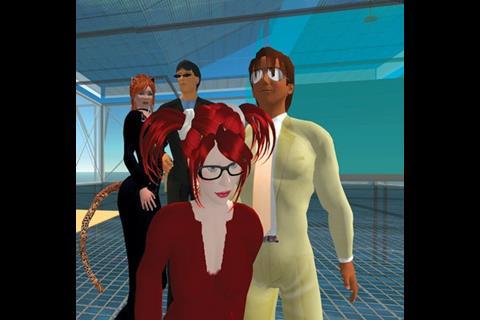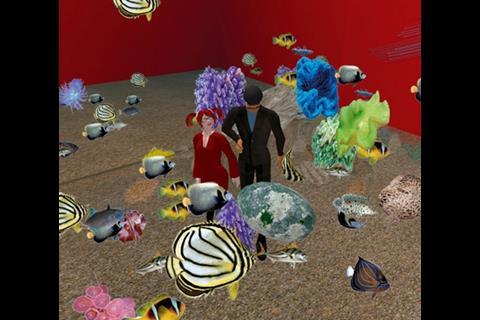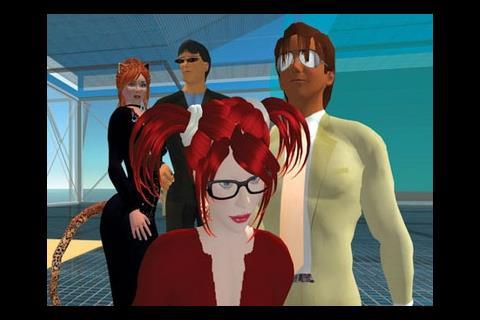Second Life is the virtual world that has its own businesses, currency and an exchange rate with real money. And where there‚Äôs real money, developers are never far behind. Katie Puckett steps ‚Äėin-world‚Äô as Katarina Rockett (she‚Äôs the one with the red bunches) to investigate the world‚Äôs first virtual construction boom
Peter Dunkley has two offices. He spends half his working life in Milton Keynes, the other half in Manhattan Beach, where palm trees sway and waves lap the shore beside his sun terrace. Sometimes clients drop by in swimwear to discuss business opportunities while reclining on white sun loungers. ‚ÄúWe‚Äôve got an underwater meeting room with fish and one that hovers in the air,‚ÄĚ he says.
Dunkley is not a billionaire. And he‚Äôs not delusional. He‚Äôs one of the residents of Second Life, the virtual reality world that claims more than 3 million real-world devotees. His online presence, or ‚Äúavatar‚ÄĚ, keeps regular hours at the Manhattan Beach office and his firm, Depo Consulting, advises real-life companies on doing business ‚Äúin-world‚ÄĚ.
Most of what you hear about Second Life sounds like a surrealist joke. Reuters has a reporter there, IBM holds business meetings, Sweden has just opened an embassy. When French National Front leader Jean-Marie Le Pen became the first politician to set up shop there, there were anti-racist protests with demonstrators hurling exploding pigs.
But after just a few hours wandering, flying and teleporting myself around Second Life, I come to the startling conclusion that it not only resembles a real world ‚Äď it is a real world. Second Life has continents, islands and cities. It has beach resorts, country retreats, shops, offices, theatres, universities, clubs and bars. It even has gun-crime, violence, sex tourism, religion and politics. You can attend press conferences, seminars, gigs, art exhibitions and if you break the law ‚Äď the terms of service of its creator Linden Labs ‚Äď you face a trial and prison.
Second Life‚Äôs residents certainly seem to believe that it‚Äôs real. Dunkley has only been offering consultancy services in Second Life since last October, but finds he‚Äôs spending increasing amounts of time there. ‚ÄúI know I sound eccentric, but to me now our office in Second Life is a real place. I spend a lot of time there chewing the fat. It‚Äôs very absorbing. I can‚Äôt be in Second Life talking to someone and doing something else at the same time ‚Äď it‚Äôs not like a telephone conference.‚ÄĚ He‚Äôs planning to buy an island to set up a business park, the virtual equivalent of managed office space. One large US company he has spoken to is considering setting up a virtual office in Second Life, not in addition to but instead of all its international premises. So everyone would be working from home, but in the same virtual office.
What sets Second Life apart from other virtual worlds is that everything in it is created by the residents, and anything you can create, you can sell to someone else. You can also hold events and charge people to attend them. Or you can get a job washing floors, being a prostitute or just working in an office. The in-world currency is the Linden dollar, and you can get about 250 to the dollar at the LindeX exchanges in-world.
There‚Äôs a lot of money to be made in Second Life ‚Äď US$1m is spent there everyday. The greatest fortunes to date have been made in property investment ‚Äď for example, a Chinese woman who has become a dollar millionaire. Right now, it‚Äôs undergoing something of a property boom. Land prices have doubled since November, pending the delivery of a new continent to relieve the pressure. Dunkley has spent US$500 on land to date, but he knows he could sell it for US$1,000 tomorrow.
Of course, where there‚Äôs property investment, there‚Äôs construction, so ļŕ∂ī…Á«Ý decided to take a look around and speak to some of the people at the heart of this boom. It was a journey that took in arms dealerships, virtual affairs, and the surprise realisation that, in a world where everything is possible, most people seem to aspire to live in Home Counties suburbia.
Architects and arm dealers
I log on as Katarina Rockett and am immediately overcome by self-consciousness as my avatar appears on screen surrounded by other people on a virtual island. I decide I must customise my appearance before I meet people. This is one of Second Life’s most popular activities and greatest moneyspinners. It goes without saying that everyone’s hotter than their real-life selves.
The appeal of Second Life is supposedly the chance to be, do and explore things that would be impossible in real life. But the more time I spend there, the more I notice how strongly real-world rules of interaction apply. I feel shy arriving at new places and wary of interrupting people’s conversations or being rude. I’m mortified when I accidentally disrobe in a crowded street. Although the people around me are socialising in a virtual universe, their conversations aren’t that different to those you’d overhear in a pub.
I search Second Life‚Äôs classifieds to find architects. Skybeam Architecture‚Äôs sell is ‚Äúļŕ∂ī…Á«Ý Dreams One Prim at a Time‚ÄĚ ‚Äď prims are the building blocks of everything in Second Life (see box, opposite). It offers ‚Äúprefabs, Victorian, Tudor, modern, furniture, gazebos, fountains and lighting‚ÄĚ.
There are places you can purchase an office cubicle ‚Äď that‚Äôs the most banal thing I can possibly imagine
Chad Oberg, AKA Chip poutine
I teleport over to Skybeam’s office and send an instant message to Charlene Trudeau, the avatar who owns it. She strides straight over with far more grace than I’ve been able to muster. Charlene is about a metre taller than I am, with long strawberry blond hair in an elaborate up-do and she’s wearing a low-cut black top and slinky flared trousers. She also has cat ears and a long swishing tail.
‚Äúhi there. welcome to skybeam :),‚ÄĚ she says. We stand on a path surrounded by her creations: a large airy house with an atrium, an intricate romanesque castle and a lush, if pixilated, garden. As we talk, our avatars perform typing gestures, although mine seems to be shuffling its feet and staring at the ground. I wonder if she thinks I‚Äôm rude.
Charlene has been building in Second Life for a couple of years and she makes between US$300 and $800 there every month. She sells dozens of her pre-made houses, and reckons she has between two and five clients a month for custom builds. ‚ÄúI‚Äôm just starting the design of an entire mall for one woman,‚ÄĚ she says, which she estimates will take about 30 hours. ‚ÄúI‚Äôm here from no later than 7am Second Life Time to usually 11pm, with breaks for real-life chores, dinner with family, etc, so I‚Äôm literally full time.‚ÄĚ Second Life Time is the same as Pacific Time ‚Äď Linden Labs are headquartered in San Francisco.
Most architects in Second Life don’t have a real-world building background. Both Charlene Trudeau and Seigmancer Nino, the second I seek out, work in IT and were drawn to the creative possibilities of the 3D programming tools. Nino has a showroom selling replicas of the world’s most famous buildings, including Dubai’s Burj Al Arab for L$15,000 (about £30).
‚ÄúI started making weapons and special effects for friends and for fun. Only about a year later I realised it could be turned into real business. I started building towers and skyscrapers because I love cities and architecture,‚ÄĚ he says.
Seigmancer is only here part-time but makes over $1,000 a month through Second Life. The Burj took about four months to make ‚Äď over 80 hours ‚Äď and he‚Äôs sold about 20. But his best-selling buildings are two Legoland-looking condos that wouldn‚Äôt look out of place in a cartoon version of Croydon.
To check out his work, I teleport to Seigmancer’s store in the district of Berkshire. Outside, exploding barrels are on sale for L$75. Inside, there’s a wall of futuristic weapons and lovingly recreated army uniforms, and also pornography, fitted kitchens and dining room furniture. It’s hard to imagine the residents of the real Berkshire welcoming such an establishment. I buy a bottle of Heineken for L$5, which sticks out from my hand at a weird angle, and wander out through the manicured lawns and rosebeds, past a pretty white church and rows of New England-style mansions.
Virtual suburbia
It looks like a lovely place to live but nothing I’ve seen exactly pushes the boundaries of architecture. Especially considering that the designers are unhindered by budget or real-world buildability. Prefab buildings may not have taken off in the real world but they’re massive in Second Life. There are no planning laws and suburban sprawl has taken hold.
Chad Oberg, or Chip Poutine to his Second Life friends, is a Canadian architect and academic at the University of Calgary who has been writing a blog reviewing the architecture of Second Life since September 2005. He‚Äôs not impressed so far. ‚ÄúIt kind of reminds me of dollhouses. The site context ‚Äď green rolling hills, mountains, trees, rivers, lakes ‚Äď to a lot of people, that demands a real world response. But if you go to one of the islands, it‚Äôs nothing to do with the real world, and that‚Äôs more what we expect virtual architecture to look like.‚ÄĚ
I mention the underwater meeting room, and Oberg says he‚Äôs fascinated by workplaces in Second Life. ‚ÄúThere are places you can purchase an office cubicle for yourself ‚Äď that‚Äôs the most banal thing I can possibly imagine. I suppose it sends the message that you‚Äôre professional, but it doesn‚Äôt really tap into what the medium has to offer.‚ÄĚ
But there are opportunities for real-world architects in Second Life apart from flogging identikit Barratt boxes. The tools in Second Life can allow you to build your creations in 3D relatively quickly and give clients a walkthrough, or attract new ones with sample designs in-world (see box, previous page).
I know I sound eccentric, but to me now our office in Second Life is a real place. I spend a lot of time there chewing the fat
Peter Dunkley, AKA chester orbit
The underwater meeting room
For most businesses, Second Life is a shop window and a networking opportunity. Depo Consulting’s office is staffed for an hour every day by Marissa Meltzer, who was recruited via an ad on Google and interviewed in Second Life. Dunkley has Marissa’s CV and knows her real name but he has never met her in the real world and has no idea what she looks like.
I teleport over to meet her and Peter Dunkley’s avatar, Chester Orbit. They stand up and come to greet me. I feel I ought to shake hands, or at least wave hello, but all I can do is stagger past them and run backwards and forwards over the chair I’m trying to sit on. It’s a bit embarrassing.
Finally I sit down and we do the weird typing in mid air thing again. Marissa‚Äôs been here for just over a month now and says she‚Äôs spoken to two major companies about using Second Life. ‚ÄúThere are many opportunities round here: advertising, direct links to your website, as well as the creative aspect. On average we get about 15 to 20 people a week coming by to have a look and a chat.‚ÄĚ
Is that from your ad on Google, I ask.
‚ÄúI think most from Google,‚ÄĚ says Chester. ‚ÄúBut the building itself has attracted a lot of visitors. Word seems to get around. And we‚Äôve met a few people who are just wandering past, that‚Äôs one of the benefits of this sort of location. I think it‚Äôs either interested neighbours or people looking at land.‚ÄĚ
But surely networking on Second Life isn‚Äôt the same? ‚ÄúI see the people that I know on here the same as real-life people,‚ÄĚ types Chester. ‚ÄúI met the head of marketing for Leo Burnett, a big advertising company in the States. There‚Äôs no networking event in the real world where that could have happened.‚ÄĚ
Aren‚Äôt there crucial differences? ‚ÄúNot really ‚Äď I made a really useful contact from someone who was having a virtual affair with a manager from some other company. The whole of life is here ‚Äď in all its weird forms.‚ÄĚ
Depo‚Äôs offices in Second Life were built by Dunkley/Chester‚Äôs brother ‚Äď an architect based in New York, whose work is drawing quite a following in-world. But Marissa and Chester both agree that Second Life is not yet living up to its potential, building-wise.
‚ÄúMost of the architecture and design is awful,‚ÄĚ says Chester. ‚ÄúBut maybe it means people really love design that we think of as bland. There‚Äôs a lot of homes that look like upmarket American places. Not great architecture, but it‚Äôs what people want.‚ÄĚ
Before I go, I ask if I can have a look at the underwater meeting room. ‚ÄúOf course,‚ÄĚ says Chester. ‚ÄúFollow me.‚ÄĚ Entering the room involves a complex flying up-forward-down manoeuvre but it‚Äôs worth it. There are tropical fish swimming around our heads and suitably muffled underwater sound effects. ‚ÄúI‚Äôm really looking forward to using this room,‚ÄĚ says Chester, ‚Äúit‚Äôs a shame we haven‚Äôt got it kitted out yet.‚ÄĚ And bizarrely, as we stand in that room without table or chairs, it seems a perfectly reasonable thing to say.
A world without contractors … Why architects are heading to Second Life
‚ÄúSecond Life is basically made for architecture,‚ÄĚ says Chad Oberg, an architect and lecturer at the University of Calgary in Canada. As an architect in Second Life, you are unfettered by concerns like buildability or budget, and you don‚Äôt need the help of clients, contractors, QSs or project managers to bring your creations to life. No wonder it appeals to real-life architects.
‚ÄúThere‚Äôs an absence of gravity, weather, cost constraints, construction ‚Äď the sky is the limit,‚ÄĚ says Bennet Dunkley, a New York-based architect who‚Äôs been building in Second Life (as Bennet Dynamo) since November. Dunkley has done five builds, the largest being Depo Consulting‚Äôs offices, which included the underwater meeting room.
There are some constraints though. Everything in Second Life is made up of ‚Äúprims‚ÄĚ (short for primitives), and each plot of land can only hold a limited number. This means complex structures are out on all but the largest sites and it makes curves difficult.
None of the architects have found Second Life‚Äôs 3D modelling tools as good as CAD products. ‚ÄúYou can‚Äôt slice objects or fillet them or get the edges of things together properly,‚ÄĚ says Dunkley.
But there‚Äôs no 3D modelling package that let‚Äôs you explore theoretical buildings in the same way. Dunkley says: ‚ÄúIn a few hours we can create an environment that a client can walk through. [With normal modelling software] you can‚Äôt walk through and look up and down, and you definitely can‚Äôt do it in the same timeframe as you can in Second Life.‚ÄĚ
There is interest from real-world 3D modelling software manufacturers. Autodesk for example has bought an island in Second Life, but Oberg says they’ve done very little since a big showy announcement at the annual conference, raising the suspicion that it was just another one-off corporate gesture.
In the meantime, he believes that constraint can be the source of creativity. ‚ÄúWhen you have a completely blank canvas it‚Äôs harder being creative.‚ÄĚ
Some constraints Dunkley could do without. The interest his creations draw in-world has led him to build a large studio where he can design without distractions. ‚ÄúIf you‚Äôre building on site, people see you working and want to stop and talk. You waste a lot of time talking. You make good contacts, but there‚Äôs the groupie contingent as well.‚ÄĚ How often in the real world can architects say that?
Setting up in Second Life
1 Get a life
The first step is to set up your own online persona, or avatar. Basic membership is free and you can register at secondlife.com, where you’ll choose your Second Life name. You need to load the Second Life software onto your computer, which takes about 15 minutes.
2 Put some clothes on and go for a walk
When you first enter the world, you‚Äôll find yourself at Orientation Island where you can customise your avatar and learn how to walk, fly and look around. Once you‚Äôre ready to explore, the Search button is a good place to start ‚Äď you can find people and places or look through the classifieds, a kind of in-world Yellow Pages.
3 Buy some land
To own land, you have to upgrade to Premium membership, which costs US$9.95 a month. You have three options ‚Äď buying your own island, buying land on the mainland or subletting from a third party. The best deals are to be found at the Dreamland continent owned by Anshe Chung ‚Äď the in-world name of the Chinese woman who‚Äôs made $1m from property investment. There, a 1,024m2 plot ‚Äď 234 prims ‚Äď costs US$6 a month.
4 Start building
Anyone can try building in Second Life, using the 3D modelling tools within the world. Or you can find an architect through the classifieds.
5 Don’t make a nuisance of yourself
‚ÄúGriefing‚ÄĚ ‚Äď generally making a nuisance of yourself ‚Äď can take many forms. Generally, you should respect the social rules you‚Äôd follow in the real world ‚Äď interrupting conversations, swearing or shouting a lot are all considered rude. Likewise, dressing inappropriately will also raise eyebrows. Peter Dunkley says: ‚ÄúWe have people turn up at the office dressed only in thongs ‚Äď that could blow a deal for us, although it adds to the entertainment value of the place.‚ÄĚ
Design ļŕ∂ī…Á«Ý‚Äôs virtual office
ļŕ∂ī…Á«Ý is opening an office in Second Life. Soon you‚Äôll be able to visit us in-world, meet industry figures and come to networking events. But first we need somewhere to sit. We‚Äôve bought some land, and now we‚Äôre holding a design competition to build our office. We‚Äôll run a two-page feature on the winner later in the year. Visit www.building.co.uk/secondlife for a more detailed brief and pictures of the site.





































1 Readers' comment